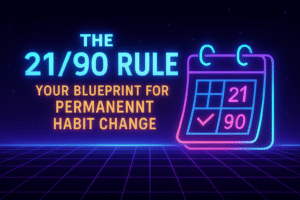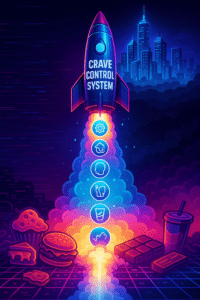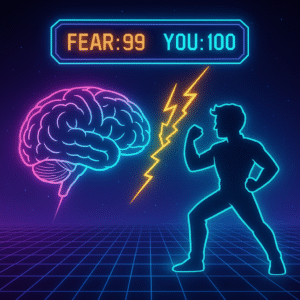Ever lose hours of progress in a video game because you forgot to save? That gut-punch feeling when you realize you have to start over?
Building habits without a proven system feels exactly like that.
You start strong. You’re motivated. Then life happens. You miss a day. Then another. Before you know it, you’re back at square one—wondering why you can’t make anything stick.
Here’s the truth: willpower isn’t your problem. Your timeline is.
The 21/90 rule offers something rare in self-improvement—a concrete, science-backed roadmap that shows you exactly where you are in the habit formation process. Think of it as the save points in your personal transformation game.
What Is the 21/90 Rule?
Let’s get precise about what the 21/90 rule actually means.
The framework is simple: Commit to a specific behavior for 21 consecutive days. At this checkpoint, the action should start feeling less foreign—your brain has begun creating shortcuts for this behavior. Continue for an additional 69 days (reaching 90 days total), and the behavior typically integrates into your identity.
Here’s what the 21/90 rule is NOT:
- A guarantee that habits become effortless after exactly 21 days
- A rigid timeline applying identically to everyone
- An excuse to give up if you miss a day
Here’s what it IS:
- A realistic framework for understanding phases of behavioral psychology
- A checkpoint system tracking genuine progress
- A timeline accounting for actual neural rewiring in your brain
- Structure making momentum building measurable
The power isn’t in magic numbers—it’s having a roadmap telling you “you’re 40% through the hardest part” when you’re on Day 9 and feeling like quitting.
The Psychology Behind the Formula: What Is the 21/90 Rule in Psychology?
To understand what is the 21/90 rule in psychology, we need to examine what’s happening in your nervous system during habit formation.
Your brain is fundamentally lazy—in a good way. It constantly looks for patterns it can automate. Every repeated behavior creates neural pathways—literal physical connections between brain cells making that behavior easier to execute next time.
Think of it like walking through a forest. The first time, you’re pushing through dense brush. By the tenth time, there’s a faint trail. By the fiftieth, there’s a clear path.
This is where the 21-day checkpoint comes in. Research in neuroplasticity shows it takes approximately 21 days of consistent repetition for your brain to begin forming these initial pathways. You’re not creating automaticity yet—you’re establishing that first rough trail.
But here’s the critical part most people miss: That initial pathway is fragile. It’s like a dirt trail that washes away after one hard rain. This is why many people who “try something for 21 days” end up right back where they started.
The 90-day completion point addresses this vulnerability. Between Day 21 and Day 90, those neural pathways undergo myelination—they get wrapped in protective coating making them fire faster and more reliably. The behavior moves from “something I’m trying to do” to “something I do.”
This is the difference between breaking bad habits temporarily and creating genuine lifestyle change.
Read More: How to Get Out of Your Comfort Zone
Who Made the 21/90 Rule? The Origins
If you’re wondering who made the 21/90 rule, the story starts with Dr. Maxwell Maltz, a plastic surgeon in the 1950s who noted patients took about 21 days to adjust to their new appearance.
But Maltz’s observation—”a minimum of about 21 days”—morphed into “it takes 21 days to form a habit” as it spread through popular psychology. The nuance got stripped away.
In 2009, University College London researcher Philippa Lally found habit formation actually ranged from 18 to 254 days, with an average of 66 days. The complexity mattered—drinking water after breakfast was quicker than doing 50 daily pushups.
The 21/90 rule isn’t one person’s invention—it’s an evolution of observations from neuroscience, psychology, and real-world coaching that converged on a practical framework accounting for:
- Initial neural adaptation (first 3 weeks)
- Pathway strengthening (weeks 4-8)
- Integration and resilience (weeks 9-13)
The Three Phases: What to Expect When
Phase 1: The Friction Zone (Days 1-21)
What’s happening: Your nervous system is in resistance mode. Every execution requires conscious decision-making. Your brain is spending actual fuel to override existing patterns.
What it feels like: Everything screams “this is unnatural.” Constant reminders needed. Easy derailment from any disruption.
The danger point: Days 7-14 are where most quit. You’ve lost novelty excitement but haven’t seen enough results to fuel motivation.
Your strategy: External structure that compensates for lack of automation. Phone alarms, visible cues, accountability partners, stupidly easy execution.
Success at Day 21: You’re not excited, but no longer actively fighting yourself.
Phase 2: The Integration Phase (Days 22-60)
What’s happening: Initial neural pathways get reinforced. Your brain recognizes patterns: “After I brush my teeth, we do this other thing.”
What it feels like: Wildly inconsistent. Some days flow naturally. Other days feel like Day 1. This is normal—you’re experiencing “intermittent automation.”
The danger point: Days 28-35 create false confidence. You’ve felt automatic execution, so you get casual about structure.
Your strategy: Connect habit to existing strong behaviors. Layer in identity reinforcement—”I’m someone who…” rather than “I’m trying to…”
Success at Day 60: The habit survived at least one major disruption and you’ve developed comeback strategies.
Phase 3: The Solidification Phase (Days 61-90)
What’s happening: Myelination occurs—those neural pathways get protective coating making them fire faster and more reliably.
What it feels like: Surprisingly unremarkable. The behavior is becoming boring—which is the goal. You’re no longer analyzing it.
Your strategy: Use this phase for optimization, not intensification. Fine-tune integration. Add small variations to prevent monotony-based drop-off.
Success at Day 90: Not doing the habit feels strange. The habit has become part of your identity, not your to-do list.
Applying the 21/90 Rule: Real-World Example
Let’s get concrete with morning reading for 15 minutes.
Pre-Launch (Day 0): Remove every excuse. Choose exact book. Pick precise time (after waking, with coffee). Stage environment (book on nightstand). Put phone charger across room. Pre-program coffee maker.
Days 1-21: Use external motivation only. Alarm labeled “Feed Your Mind.” Physical reward tokens. Text accountability partner after each session. If you want to skip, do 5 minutes instead of 15—keep the chain alive.
Days 22-60: Reading links to coffee ritual. The habit survives your first weekend differently than weekdays. Pre-plan comeback for disruptions: “I’ll read 5 minutes in the car if needed.” You shift from “trying to read daily” to being a person who reads.
Days 61-90: Reading feels as natural as brushing teeth. You’re focused on what you’re reading, not whether. Fine-tune timing based on learning. Document ripple effects (better focus, less phone addiction).
After Day 90: The habit is established. Your nervous system built the neural pathways. Now it’s about maintenance, not formation.
Read More: 5 Reasons You Feel Lost in Life
What Happens After 90 Days?
What happens after 90 days? Day 90 isn’t a finish line—it’s graduation. You’ve created “functional automaticity”—the behavior happens with minimal conscious effort under normal conditions.
What still threatens it: Major life disruptions (moving, job change), extended breaks (vacations, illness lasting over a week), environmental changes, identity challenges.
Post-90 maintenance: Weekly awareness check-ins. Disruption protocols. Quarterly optimization. Identity reinforcement.
The compound effect: After 90 days, you have mental space for another habit. The second habit is easier because you’ve trained your brain in the meta-skill of habit formation itself.
Signs it’s truly established:
- You feel “off” when you don’t do it
- You’ve done it automatically during stress without thinking
- You can’t remember consciously deciding to do it recently
- Other people associate this behavior with your identity
Read More: How to Be the Best Version of Yourself
Does the 21 Day Rule Work? The Reality
Does the 21 day rule work? The honest answer: It’s more nuanced than yes or no.
Research shows something shifts around weeks 2-3 for simple habits. Your brain recognizes patterns. But “less hard” isn’t “automatic.”
The 21/90 rule works not because numbers are magical, but because they provide realistic framework accounting for how your nervous system rewires. Is the timeline exact for everyone? No. But it’s far more accurate than “just stick with it” or “21 days makes it permanent.”
Studies on complex behavior change consistently show 66-84 days to reach automaticity—aligning perfectly with the 90-day framework.
Is It True 21 Days to Break a Habit?
Is it true 21 days to break a habit? No. The 21-day figure is only the beginning, not completion. While your brain begins forming new pathways around Day 21, this wiring is fragile.
True habit transformation—whether building or breaking—requires the full 90-day cycle for lasting change. You need that extended period for neural pathway strengthening, environmental integration, identity shift, and resilience building.
Read More: 90 Day Transformation
The Foundation for Transformation
The 21/90 rule isn’t magic. It’s a realistic framework aligning with how your nervous system actually works.
It respects the science of neural pathways while accounting for messy human psychology. It gives concrete checkpoints when the process feels abstract.
Most importantly, it works—when you work it.
You now know what’s happening in your brain during each phase, why Day 14 feels different than Day 44, and what success looks like at each checkpoint.
The only question left: What’s the one habit you’re committing to for the next 90 days?
Choose something meaningful. Something specific. Something you can track with binary clarity.
Then treat the next 90 days like the experiment it is—not a test of your worth, but a test of the framework’s ability to rewire your nervous system when you feed it consistency.
Your brain is ready to change. Now it has the roadmap.
🚀 DISCOVER WHICH HABIT WILL CREATE YOUR BIGGEST BREAKTHROUGH
You’ve learned the science of the 21/90 rule—but which habit should you tackle first?
Take our AI-Powered Core Values Quiz and discover exactly where to focus for maximum impact. In under 60 seconds, you’ll get your personalized momentum score across all 5 Core Areas of Life and the specific habit that will create a ripple effect across your entire life.
The 21/90 rule gives you the timeline—the Moore Momentum System gives you the precision targeting, behavioral science strategies, and gamified accountability to make it inevitable.
Take the Core Values Quiz NOW and discover your personalized starting point!
🚀🚀🚀 Don’t forget to check out our RESOURCE ARCADE 👾🎮 for FREE templates and tools to gamify your habits.
FAQs About 21/90 Rule
What happens after 90 days?
After 90 days, your habit has reached functional automaticity—it runs under normal conditions without conscious effort. However, it still needs occasional attention during major disruptions. Think of it as graduated maintenance rather than “set and forget.”
Is it True 21 Days to Break a Habit?
No. The 21-day figure is only the beginning of habit change, not completion. While your brain begins forming new neural pathways around Day 21, this initial wiring is fragile. True habit transformation requires the full 90-day cycle for lasting change.






